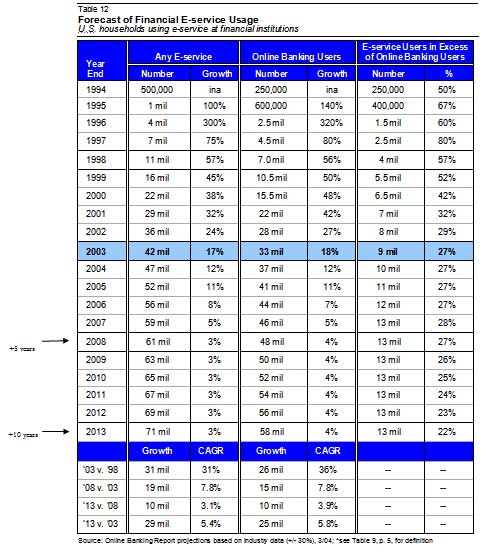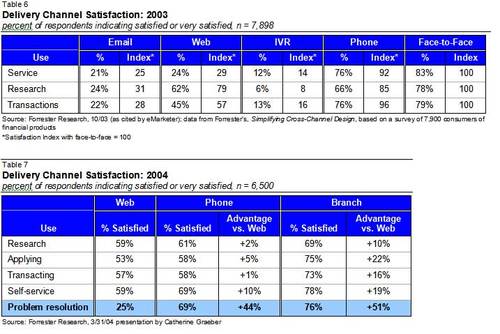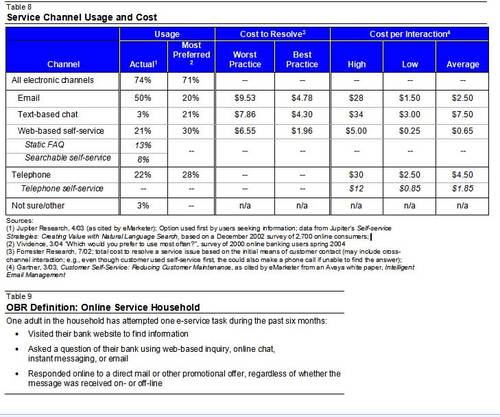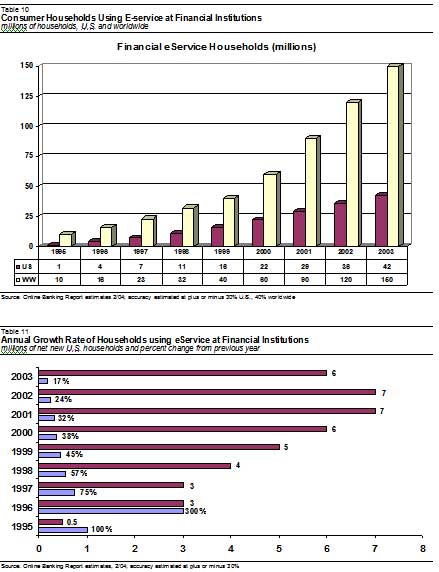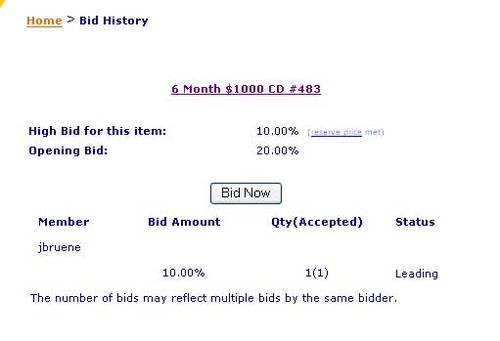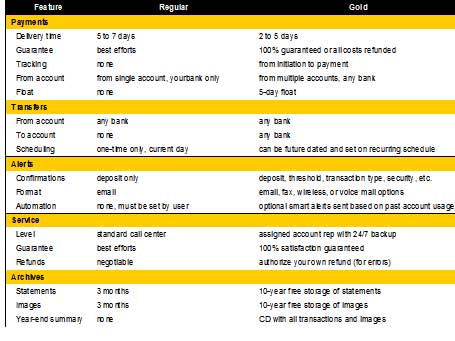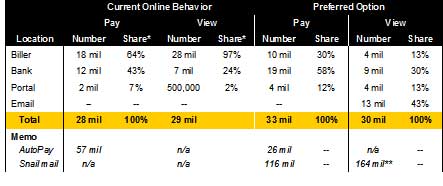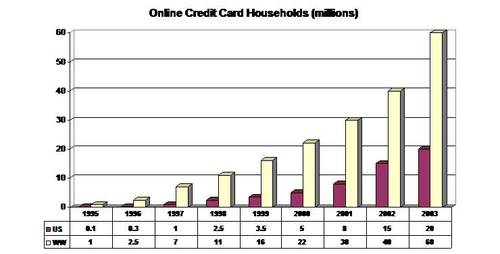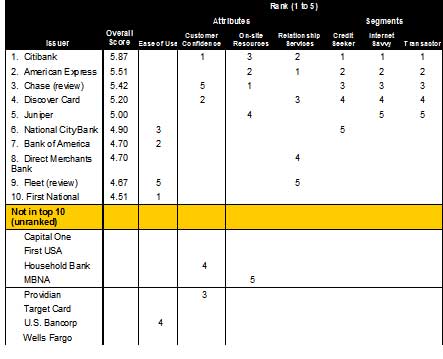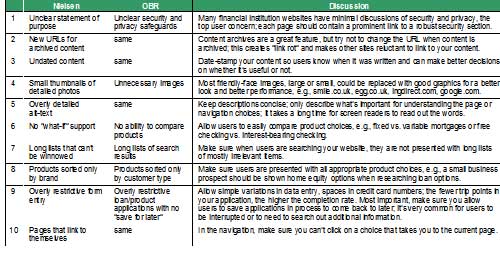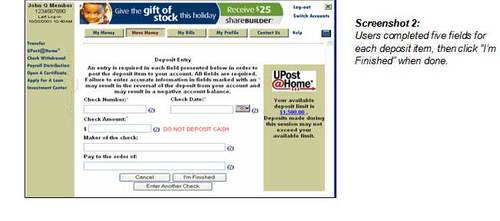Looking back at 2003, we selected 10 industry
developments that provide the best glimpse at the future of online financial
services delivery.
Innovation of the Year
Premium Online Banking: Money HQ from Online Resources

Money HQ from Online Resources earns 2003’s Innovation
of the Year and number 15 on our all-time list for its innovative
packaging of several advanced features into a fee-based premium service. The
new service, powered by CashEdge, combines account aggregation and
interbank payment services. It’s accessed via a tab (far-right) on Online
Resources Internet banking platform (see screenshot below left).
The premium service offering is optional for client financial
institutions, but with zero out-of-pocket costs, the company expects
widespread adoption. Currently, 40 out of 500 clients are live with the
service, including First Command Bank (Fort Worth, TX) and
Pinnacle Federal Credit Union (Edison, NJ).
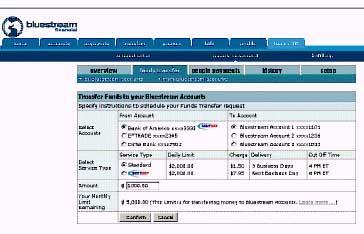
Suggested retail price is $5/mo plus transaction fees for certain A2A
transfers. Revenues are shared between the financial institution and Online
Resources.
Two
Phishing undermines trust (for now)
Not coincidently, just when mainstream users were beginning to trust
online financial services, along comes the mass phisher, spamming the world
with hundreds of millions of fraudulent emails purporting to be from the
user’s bank, credit card company, or ISP. Unfortunately, the problem is
going to get worse before it gets better. Anti-phishing.org, a
non-profit bankrolled by Tumbleweed Communications, identified 60
unique phishing attacks in the two weeks before Christmas, which unleashed
an estimated 60 million fraudulent messages. Not until an authentication
protocol is widely adopted (hopefully, by early to mid-2005) will the
onslaught of fraudulent emails slow.

|
A recent phishing attempt aimed at Bank One went out under
the guise of a phishing warning. Recipients were asked to login
to their Bank One accounts to learn more about fraudulent
emails.
|
The media is beginning to jump on this story, with phishing mentioned
in 103 major articles during the past 30 days, compared to just 17 during
the entire first half of 2003. The resulting consumer awareness will help
keep users from being caught in the trap, but it will also lead to
significant problems in marketing new services via email, hampering
financial institutions’ efforts to turn a profit online. For a sobering view
on the subject read the Wall Street Journal Online’s Jan. 19, 2004
article, Stink in Your E-mail Box Means Big Trouble for Marketers.
Long-term, as techniques such as digital signatures eliminate most casual
phishing efforts, it will be a non-issue. In fact, these scares tend to be
good for existing financial institutions whose customers are even less
likely to venture to a new provider .
Three
Banks move to boost security perceptions
After a quiet first half of the year, banks were hit with a number of
highly publicized security intrusions. First, the South Africa press had a
field day with a keylogging incident that became public knowledge in May
. Other incident in the UK and New York were also publicized, but at a far
lower level than the South Africa incident. Then beginning with two Wall
Street Journal stories this summer (July 22 and August 19) and
continuing until year-end, the endless phishing attacks garnered a
significant amount of press, nearly 500 articles in the past six months
contained the word phishing.
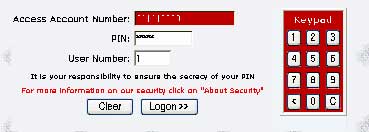
Banks, understanding what’s at stake, took decisive actions to reassure
online banking users and prospects. For example, within weeks of its
keylogging breach, ABSA Bank installed numerous new authentication tools to
virtually eliminate the threat. Its most visible change: an optional virtual
keypad allowing wary users to “type” in their PIN codes (see inset).
This defeats most keylogging since the hacker would have to map mouse
coordinates to determine which digits were selected. In addition, the bank
instituted a rotating secondary password requirement for users to move money
out of their accounts or change personal information.
Four
Citibank launches interbank transfers (A2A)
Five years ago (Oct. 1998), when the ill-fated CompuBank first
launched its online services, it included an innovative interbank
funds-transfer system (A2A). At the time, we expected it to become common
within a few years. But other than the Internet-only banks such as ING
Direct and E*TradeBank, the service has not caught on in the
United States. In fact, no major U.S. bank offered it until the fall of 2003
when Citibank added interbank transfers to its online banking
program. CashEdge, which also powers Money HQ from Online
Resources operates the transfer system behind the scenes.
Citibank, which for several years has boasted a top-rated online banking
service based on ranking
by Gomez, Forbes www.forbes.com/bow
and others, may earn a new round of kudos by being an industry leader in
A2A. Just this week Forbes bestowed its Best of the Web on Citibank
once again (see Table 15, right), specifically mentioning the A2A
functionality.
Table 15
Forbes Favorites: Personal Finance & Investing
|
Category |
Best of the Web |
| 401k Advice |
MPower Cafe |
| Auto Insurance |
InsWeb |
| Banking |
Citibank.com |
| Brokers |
Charles Schwab |
| Calculators |
FinanCenter |
| Credit Cards & Loans |
Bankrate.com |
| Debt Management |
About.com Credit/Debt Mgmt. |
| Estate Planning |
Nolo.com |
| Financial Planning |
Financial Engines |
| Financial Portal |
MSN Money |
| Full Service Broker |
JP Morgan Online |
| Fund Families |
Vanguard Group |
| Fund Selection |
Morningstar |
| Life Insurance |
Quotesmith.com |
| Mortgages |
Quicken Loans |
| Tax Planning |
Internal Revenue Service |
Source: Forbes, 1/04
Five
Press turns positive online banking and other online
financial activities
A year ago, much of the mass media was negative or neutral on the overall
benefits of online banking. Reporters were still looking for examples of
dot-com excesses and often invoked the names of Wingspan,
CompuBank, and Citi f/i as examples of online banking’s failed
promise. Never mind that the service was growing faster than ever in terms
of net new households. During 2003, the negative reporting gradually gave
way to new stories about convenience, ease-of-use, and good value
(especially with the elimination of bill pay fees). In 2004, we expect a
mini-backlash as the press focuses on the phishing threat, but overall we
expect the media to embrace online banking for years to come.
Six
Bank of America hits seven million users

|
On its homepage, BofA is currently promoting free bill
payment’s potential cost savings of $53
(Jan 20, 2004).
|
At year-end, Bank of America had as many online banking customers as
all U.S. banks combined had five years ago (at year-end 1998). The bank’s 7
million active users account for 43% of its checking account base, and 22%
of all households. Year-over-year growth was an impressive 50%, with 2.3
million new active users. Total enrollment, active and inactive, is now 10
million. Bill payment growth was even stronger, spurred in part by its
high-profile campaign touting free bill payment which began in mid-2002 and
continued through 2003 (see inset). More than 1.2 million new bill
pay users came on board in 2003, a 67% increase, ending the year at more
than 3 million, the largest bill payment base in the country.
Table 16
BofA Online Banking & Bill-Pay Users Trend
active users (past 90 days)
|
|
Online Banking |
Bill Payment |
|
Date Reported |
Num |
% OB |
| Dec. 18, 2003 |
7.0 mil |
3.0 mil |
43% |
| Oct. 21, 2003 |
6.6 mil |
2.8 mil |
42% |
| Sep 22, 2003 |
6.2 mil |
2.6 mil |
42% |
| Aug. 26, 2003 |
6.0 mil |
2.6 mil |
43% |
| July 24, 2003 |
5.7 mil |
2.4 mil |
42% |
| June 19, 2003 |
5.5 mil |
2.3 mil |
42% |
| Mar 25, 2003 |
5.0 mil |
2.0 mil |
40% |
| Jan. 1, 2003 |
4.7 mil |
1.8 mil |
38% |
| Nov. 27, 2002 |
4.4 mil |
1.5 mil |
34% |
| Oct. 30, 2002 |
4.3 mil |
1.5 mil |
35% |
| Aug. 2002 |
4.2 mil |
ina |
— |
| May 9, 2002 |
3.3 mil |
1.1 mil |
33% |
| March 2002 |
3.1 mil |
900,000 |
29% |
| Dec 2001 |
2.9 mil |
ina |
— |
| Dec. 2000 |
1.8 mil |
ina |
— |
| 3-year growth |
5.2 mil |
|
|
Source: Bank of America, 2001-2003
DDA = demand deposit account (checking)
Table 17
BofA Online Banking & Bill-Pay Metrics
November 2003
| Website Traffic |
Value |
|
Unique visitors per month* |
8.9 million |
|
Number of visits per month* |
71.0 million |
| Online Banking |
|
|
Total subscribers |
9.9 million |
|
Active subscribers (past 90 days) |
7.0 million |
|
Inactive subscribers |
2.9 million |
|
Active subscribers, % of all HHs |
22.1% |
|
Active subscribers, % of DDA HHs |
43.0% |
|
Subscribers added monthly* |
441,000 |
|
% BofA associates actively using |
81.5% |
| Online Bill Pay |
|
|
Active bill payers |
3.1 million |
|
Bills paid per month* |
16.1 million |
|
$$ processed per month* |
$4.5 billion |
|
eBills delivered per month |
2,360,000 |
|
eBillers |
300 |
| Online bill pay customers have: |
|
| 80% lower attrition rate |
|
| 30% fewer calls to call centers |
|
| 38% higher deposit balances |
|
| 45% higher loan balances |
|
| |
|
|
Source: Bank of America, 11/03
*average monthly rate past 3 months
Seven
The decline of paper statements begins
Although it will take the better part of the decade before even 50% of
online banking customers turn off their paper statements, 2003 marked the
beginning of the inevitable decline in paper statements.
Table 18
Market Share: Paper Statements vs. Electronic Statements
U.S. checking/share draft accounts
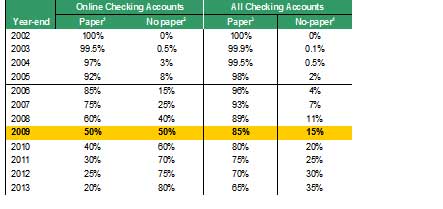
Source: Online Banking Report estimates, +/- 50%
1Percent of all online-enabled demand deposit
accounts (DDA) receiving monthly paper statements, can also be receiving an
electronic statement
2Percent of all online-enabled DDAs with
no paper statement
3Percent of all DDAs receiving a monthly paper statement, can
also be receiving an electronic statement
4Percent of all DDAs with no paper statement
Eight
Banks redesign websites for Yahoo-like clarity
Each year since the industry got through its Y2K headaches, bank websites
have made dramatic usability improvements. Last year, the most notable
redesign was at Web-banking pioneer Wells Fargo. Every financial
institution should show similar restraint in limiting homepage promotions
and extraneous text. National City and Wachovia also
introduced similar-looking homepage styles.

Nine
Real-time credit for remote deposits
E*TradeBank and Pennsylvania State Employees Credit Union
both earned OBR Best of the Web awards with creative solutions to the
remote banking bugaboo, delays and uncertainties in deposit posting. PSECU
was especially innovative, earning the 23rd spot on our list of all-time
online banking innovations by providing immediate credit for deposits being
mailed to the CU. Not only is it a great online banking benefit, it has
saves the CU more than $100,000 in interchange costs. Pentagon Federal
Credit Union launched a similar service in October, dubbed Trust In
You.
Ten
Identity Theft 911 provides a credible source to fight
ID theft

Identity theft was raised from an obscure crime to dinner conversation in
late summer when the FTC released survey results indicating that everyone in
America has assumed the identity of someone else, or so it seems if you read
all the press accounts. Actually, the FTC reported that 10 million U.S.
adults (5% of the total) fell victim to identity theft (including credit
card theft) during the past five years, far higher than anyone suspected.
Even if you discount the results due to survey methodology, identity theft
claims more than one million victims a year, a huge problem.
Luckily, the private sector stepped up to the table with consumer
protection services. Identity Theft 911 appears to be an early leader,
offering insurance, victim resolution services, credit report monitoring,
and educational material. The company markets directly to consumers, but its
business model revolves around wholesaling services to banks and corporate
employee-assistance centers.
